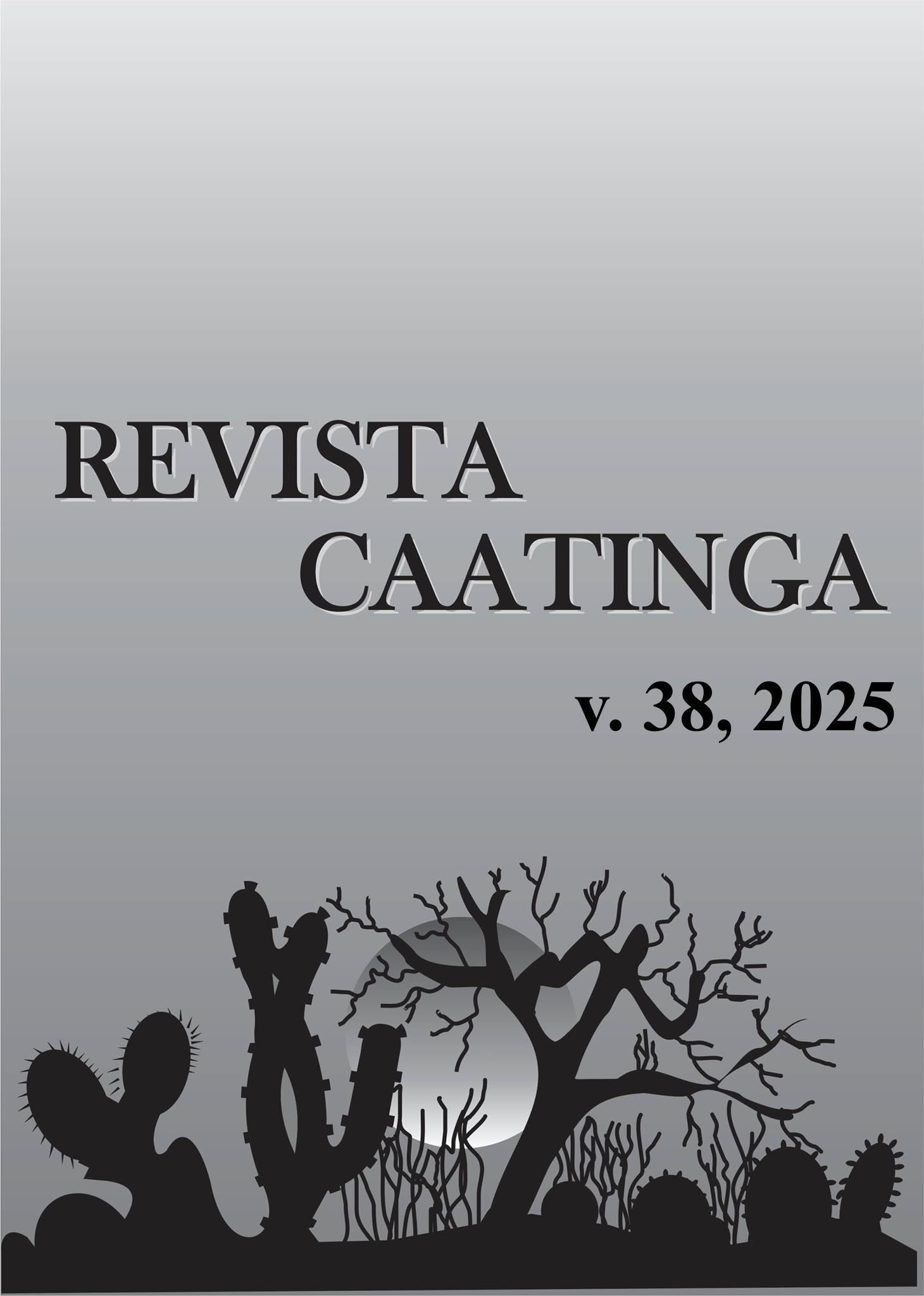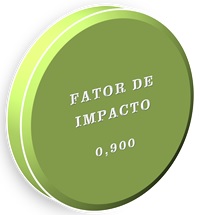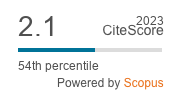Selectivity of aqueous and alcoholic extracts of Calotropis procera on the predator Euborellia annulipes
DOI:
https://doi.org/10.1590/1983-21252025v3812855rcKeywords:
Earwig. Integrated Pest Management. Giant Milkweed. Natural enemies.Abstract
Extracts from plants, such as giant milkweed (Calotropis procera Aiton, 1811), have been employed in pest management due to their insecticidal potential and safety for humans and animals. However, applying these products in crops may lead to a reduction in natural enemies, such as the earwig (Euborellia annulipes Lucas, 1847), an important ally in biological control. Thus, there is a need to test whether the extract of C. procera affects the survival and biological parameters of E. annulipes. This study aimed to evaluate the effects of aqueous and alcoholic extracts of C. procera at different concentrations on the survival and morphological aspects of the predator E. annulipes. The study was conducted in the Invertebrate Laboratory of the Department of Biosciences at the Center for Agricultural Sciences, Federal University of Paraíba, Campus II, Areia, PB, Brazil, under controlled conditions. Concentrations of 5, 10, 15, and 20% of aqueous and alcoholic extracts from C. procera leaves were tested with topical application on nymphs and adults of E. annulipes. Insect survival, instar duration, body size, and head capsule length were evaluated. Under laboratory conditions, the aqueous extract of C. procera is harmless to E. annulipes; the alcoholic extract is harmless at concentrations of 5, 10, and 15% and moderately toxic at 20%. The alcoholic extract decreases, while the aqueous extract increases, the duration of instars in E. annulipes. Higher concentrations of the alcoholic extract reduce predator size and head capsule length.
Downloads
References
ABBOTT, W. S. A method of computing the effectiveness of an insecticide. Journal of Economic Entomology, 18: 265-267, 1925.
BADER, A. et al. Systematic Phytochemical Screening of Different Organs of Calotropis procera and the Ovicidal Effect of Their Extracts to the Foodstuff Pest Cadra cautella. Molecules, 26: 905-920, 2021.
BENELLI, G. et al. Neem (Azadirachta indica): towards the ideal insecticide? Natural Product Research, 31: 369-386, 2017.
BOLLER, E. F. et al. Working document on selectivity of pesticides. International Organization for Biological and Integrated Control of Noxious Animals and Plants. (2005). Available at: <http://www.iobc.ch/2005/Working%Document%20Pesticides_Explanations.pdf>. Access on: Feb. 2, 2024.
DARA, S. K. The new integrated pest management paradigm for the modern age. Journal of Integrated Pest Management, 10: 1-9, 2019.
EL-HEFNY, A. A. Sublethal Effects of the Milky Latex of Sodom Apple, Calotropis procera (Alton) on the Growth, development, and some Physiological Aspects of the Greater Wax Moth, Galleria mellonella (L.) (Lepidoptera: Pyralidae). Journal of Plant Protection and Pathology, 10: 491-496, 2019.
FERREIRA, L. H. G. et al. Potencial de utilização de extratos vegetais como aditivo natural para melhoria da qualidade de ovos–revisão. Brazilian Journal of Animal and Environmental Research, 7: e69287-e69287, 2024.
GUIMARÃES, M. R. F. et al. Avanços na Metodologia de Criação de Doru luteipes (Scudder, 1876) (Dermaptera: Forficulidae). In: CONGRESSO NACIONAL DE MILHO E SORGO, 26., 2006, Sete Lagoas. Anais… ABMS, Sete Lagoas: 2006. p. 1-7.
HASSAN, L. M. et al. The biology of Calotropis procera (Aiton) WT. Trees, 29: 311-320, 2015.
KHAN, S. et al. Insecticidal activity of plant-derived extracts against different economically important pest insects. Phytoparasitica, 45: 113-124, 2017.
KHATTER, N. A.; ABULDAHAB, F. F. Insecticidal activity of Calotropis procera extracted groups on some biochemical aspects of the house fly, Musca domestica vicina (Diptera: Muscidae). American Journal of Science, 8: 687-693, 2012.
LANTERI, A. A.; DEL RÍO, M. G. Filogenia de Hexapoda. In: ROIG-JUÑENT, S.; CLAPS, L. E.; MORRONE, J. J. (Eds.) Biodiversidad de Artrópodos Argentinos. Buenos Aires: Museo de La Plata, 2011. v. 3, p. 49-66.
MACHADO, A. V. A. et al. Selective insecticides secure natural enemies action in cotton pest management. Ecotoxicology and Environmental Safety, 184: 109669, 2019.
MENDONÇA, A. T. et al. A utilização dos extratos hidroalcoólico e alcoólico de Eugenia uniflora L. como agente antibacteriano. Revista da Universidade Vale do Rio Verde, 14: 826-833, 2016.
NUNES, G. S. et al. Predation of diamondback moth larvae and pupae by Euborellia annulipes. Revista Brasileira de Ciências Agrárias, 13: 1-8, 2018.
OLIVEIRA, A. H. B. et al. The legacy of organochlorine pesticide usage in a tropical semi-arid region (Jaguaribe River, Ceará, Brazil): Implications of the influence of sediment parameters on occurrence, distribution and fate. Science of the Total Environment, 542: 254-263, 2016.
PANDEY, A.; TRIPATHI, S. Concept of Standardization, Extraction and Pre Phytochemical Screening Strategies for Herbal Drug. Journal of Pharmacognosy and Phytochemistry, 2: 115-119, 2014.
PERERA, A. G. W. U.; KARUNARATNE, M. M. S. C.; CHINTHAKA, S. D. M. Prolonged repellent activity of Ruta graveolens essential oil adsorbed on different mineral matrices against Sitophilus zeamais (L.) (Coleoptera: Curculionidae). Journal of Stored Products Research, 97: 101976, 2022.
R DEVELOPMENT CORE TEAM. R: A language and environment for statistical computing. R Foundation for Statistical Computing. Vienna: R Foundation for Statistical Computing. 2022.
RAMOS, M. V. et al. Performance of distinct crop pests reared on diets enriched with latex proteins from Calotropis procera: role of laticifer proteins in plant defense. Plant science, 173: 349-357, 2007.
REZAEI, R.; SAFA, L.; GANJKHANLOO, M. M. Understanding farmers’ ecological conservation behavior regarding the use of integrated pest management-an application of the technology acceptance model. Global Ecology and Conservation, 22: e00941, 2020.
SAYED, R. A. et al. Insecticidal properties of some plant extracts against cotton leafworm Spodoptera littoralis (boisd). Sinai Journal of Applied Sciences, 6: 111-120, 2017.
SILVA, A. B.; BATISTA, J. L.; BRITO, C. H. Aspectos biológicos de Euborellia annulipes (Dermaptera: Anisolabididae) alimentada com o pulgão Hyadaphis foeniculi (Hemiptera: Aphididae). Revista Caatinga, 23: 21-27, 2010.
SILVA, A. B.; BATISTA, J. L.; BRITO, C. H. Capacidade predatória de Euborellia annulipes (Lucas, 1847) sobre Spodoptera frugiperda (Smith, 1797). Acta Scientiarum Agronomy, 31: 7-11, 2009.
SILVA, A. B.; BRITO, J. M. Bioecologia de Euborellia annulipes: Dermaptera: Anisolabididae. Revista Verde de Agroecologia e Desenvolvimento Sustentável, 9: 55-61, 2014.
SOUZA, C. S. F. et al. Controle biológico: qual espécie de tesourinha consome mais lagartas e pode ser menos sensível à exposição a inseticidas?. 1. ed. Sete Lagoas, MG: Embrapa, 2019. 25 p. (Boletim de Pesquisa e Desenvolvimento, 188).
SOUZA, J. M. et al. Predation of Diatraea saccharalis eggs and neonates by the earwig Euborellia annulipes. Biological Control, 172: 104953, 2022.
VATS, T. K. et al. Deterrent effect of Calotropis procera R. Br. on feeding, oviposition and egg hatchability of Plutella xylostella (L.) (Lepidoptera: Plutellidae). Journal of Asia-Pacific Entomology, 26: 102081, 2023.
ZHOU W. et al. Integrated pest management: an update on the sustainability approach to crop protection. ACS Omega, 9: 41130-41147, 2024.
ZOTTI, M. J. et al. Seletividade de inseticidas usados na cultura do milho para ovos e ninfas do predador Doru lineare (Eschcholtz, 1822) (Dermaptera: Forficulidae). Arquivos do Instituto Biológico, 77: 111-118, 2010.
Downloads
Published
Issue
Section
License
Os Autores que publicam na Revista Caatinga concordam com os seguintes termos:
a) Os Autores mantêm os direitos autorais e concedem à revista o direito de primeira publicação, com o trabalho simultaneamente licenciado sob a Licença Creative Commons do tipo atribuição CC-BY, para todo o conteúdo do periódico, exceto onde estiver identificado, que permite o compartilhamento do trabalho com reconhecimento da autoria e publicação inicial nesta revista, sem fins comerciais.
b) Os Autores têm autorização para distribuição não-exclusiva da versão do trabalho publicada nesta revista (ex.: publicar em repositório institucional ou como capítulo de livro), com reconhecimento de autoria e publicação inicial nesta revista.
c) Os Autores têm permissão e são estimulados a publicar e distribuir seu trabalho online (ex.: em repositórios institucionais ou na sua página pessoal) a qualquer ponto antes ou durante o processo editorial, já que isso pode gerar alterações produtivas, bem como aumentar o impacto e a citação do trabalho publicado (Veja O Efeito do Acesso Livre).







